Week-6 (UMPLE-I)
CE204 Object-Oriented Programming¶
Week-6 (UMPLE - Part 1)¶
Spring Semester, 2021-2022¶
Download DOC-PDF, DOC-DOCX, SLIDE, PPTX,
UMPLE¶
Common Scope¶
- What is UMPLE?
- What is its purpose?
- How to create a UML model with UMPLE?
- What is philosophy of UMPLE?
Common Scope¶
- How to use UMPLE?
- UMPLE Online
- Command-Line
- Eclipse Plugin
- Visual Studio Code Plugin
Common Scope¶
- How to learn UMPLE?
- Online Documentations
- Video Tutorials
- UMPLE Community
Common Scope¶
- Overview of the basics of UMPLE
- Associations in UMPLE
- State machines in UMPLE
- Product lines in UMPLE: Mixins and Mixsets
- Other separation of concerns mechanisms: (Aspects and traits) and their code generation
- Other advanced features of UMPLE
- Hands-on exercise developing versions of a concurrent system using state machines and product lines.
- UMPLE as written in itself: A case study.
Common Scope¶
- Introduction:
- Overview of Model-Driven Development
- Languages / Tools / Motivation for UMPLE
- Class Modeling
- Tools / Attributes / Methods / Associations / Exercises / Patterns
- Modeling with State Machines
- Basics / Concurrency / Case study and exercises
- Separation of Concerns in Models
- Mixins / Aspects / Traits
- More Case Studies and Hands-on Exercises
- UMPLE in itself / Real-Time / Data Oriented
- Conclusion
Outline - UMPLE Part 1¶
- Introduction to UMPLE
- Motivation for developing UMPLE
- Some key UMPLE innovations
- Using UMPLE
- UMPLE Philosophy
- UMPLE Class Modeling
Outline - UMPLE Part 1¶
- UMPLE Online Usage
- UMPLE Attributes
- UMPLE Generalization and interfaces
- UMPLE Methods
- UMPLE Associations
Introduction to UMPLE¶
UMPLE: Simple, Ample, UML Programming Language¶
-
Open source textual modelling tool set for 3 platforms
-
Command line compiler
-
Web-based tool (UMPLEOnline) for demos and education
-
Eclipse plugin
-
Code generator for UML ++
-
Infinitely nested state machines, with concurrency
-
Proper referential integrity and multiplicity constraints on associations
-
Traits, mixins, aspects for modularity
-
Text generation templates, patterns, traits
-
Pre-processor to add UML, patterns and other features on top of Java, PhP, C++ and other languages
UMPLE: Simple, Ample, UML Programming Language¶
- Open source textual modeling tool and code generator
- Adds modeling to Java,. C++, PHP
- A sample of features
- Referential integrity on associations
- Code generation for patterns
- Blending of conventional code with models
- Infinitely nested state machines, with concurrency
- Separation of concerns for models: mixins, traits, mixsets, aspects
- Tools
- Command line compiler
- Web-based tool (UMPLEOnline) for demos and education
- Plugins for Eclipse and other tools
What Are we Going to Learn About in This Tutorial? What Will You Be Able To Do?¶
- Modeling using class diagrams
- Attributes, Associations, Methods, Patterns, Constraints
- Modeling using state diagrams
- States, Events, Transitions, Guards, Nesting, Actions, Activities
- Concurrency
- Separation of Concerns in Models
- Mixins, Traits, Aspects, Mixsets
- Practice with a examples focusing on state machines and product lines
- Building a complete system in UMPLE
What Technology Will You Need?¶
- As a minimum: Any web browser.
- For a richer command-line experience
- A computer (laptop) with Java 8-14 JDK
- Mac and Linux are the easiest platforms, but Windows also will work
- Download UMPLE Jar at http://dl.UMPLE.org
- You can also run UMPLE in Docker: http://docker.UMPLE.org
Key Websites¶
-
Entry-point: https://www.UMPLE.org
-
Everything you need to get started with UMPLE
-
Github: https://github.com/UMPLE/UMPLE
-
Source code and examples for UMPLE
-
UMPLE Online: https://try.UMPLE.org
-
Online application for UMPLE
Key Websites (Another way)¶
The UMPLEOnline web interface is at try.UMPLE.org
The user manual is at manual.UMPLE.org
The UMPLE home page is at www.UMPLE.org
UMPLE download page: dl.UMPLE.org
Motivation for developing UMPLE¶
Motivation for developing UMPLE (1)¶
Designers want the best combination of features:
-
Textual editing and blending with other languages
-
Ability to use in an agile process
-
Write tests, continuous integration, versioning
-
Combine the best of agility and modeling
-
Excellent code generation
-
A complete generation of real systems (including itself)
-
Multi-platform (command line, Eclipse, VsCode, Web)
-
Practical and easy to use for developers
-
Including great documentation
-
Open source
Motivation for developing UMPLE (2)¶
Many existing tools:
-
Lacked in usability
-
Awkward to edit diagrams
-
Many steps to do a task
-
Lengthy learning process
-
Lack in ongoing support
-
Could be enhanced by us perhaps, but we would be tied to key decisions (e.g. Eclipse-only)
Some key UMPLE innovations¶
Some key UMPLE innovations¶
-
Model is code
-
Traditional code is embedded in model
-
No need to edit generated code
-
No round-trip engineering
Using UMPLE¶
Using UMPLE¶
-
We will mostly be using
-
UMPLEonline
-
In a web browser: http://try.UMPLE.org
-
Or in Docker: http://docker.UMPLE.org
-
-
UMPLE on the command line: http://dl.UMPLE.org
-
Needs Java 8 JDK on the command line:
-
- Java 9 works well too
-
Docker Container Experimental¶
Using UMPLE¶
-
Optional:
-
UMPLE in Eclipse
-
cmake and gcc for compiling C++ code
UMPLE Philosophy¶
UMPLE Philosophy 1-4¶
-
P1. Modeling is programming and vice versa
-
P2. An UMPLE programmer should never need to edit generated code to accomplish any task.
-
P3. The UMPLE compiler can accept and generate code that uses nothing but UML abstractions.
-
The above is the inverse of the following
-
P4. A program without UMPLE features can be compiled by an UMPLE compiler.
-
e.g. input Java results in the same as output
UMPLE Philosophy 5-8¶
-
P5. A programmer can incrementally add UMPLE features to an existing program
-
Umplification
-
P6. UMPLE extends the base language in a minimally invasive and safe way.
-
P7. UMPLE features can be created and viewed diagrammatically or textually
-
P8. UMPLE goes beyond UML
UMPLE Class Modeling¶
UMPLE Class Models - Quick Overview¶
-
Key elements:
-
Classes
-
Attributes
-
Associations
-
Generalizations
-
Methods
-
We will look at all these using examples via UMPLE ONLINE
-
UMPLE code/models are stored in files with suffix .ump
Exercise: Compiling and changing a model¶
-
Look at the example at the bottom of
-
http://helloworld.UMPLE.org (also on next slide)
- Observe: attribute, association, class hierarchy, mixin
-
Click on Load the above code into UMPLEOnline
-
Observe and modify the diagram
- Add an attribute
- Make a multiplicity error, then undo
- Generate code and take a look
- Download, compile and run if you want
Hello World Example 2 in the User Manual¶
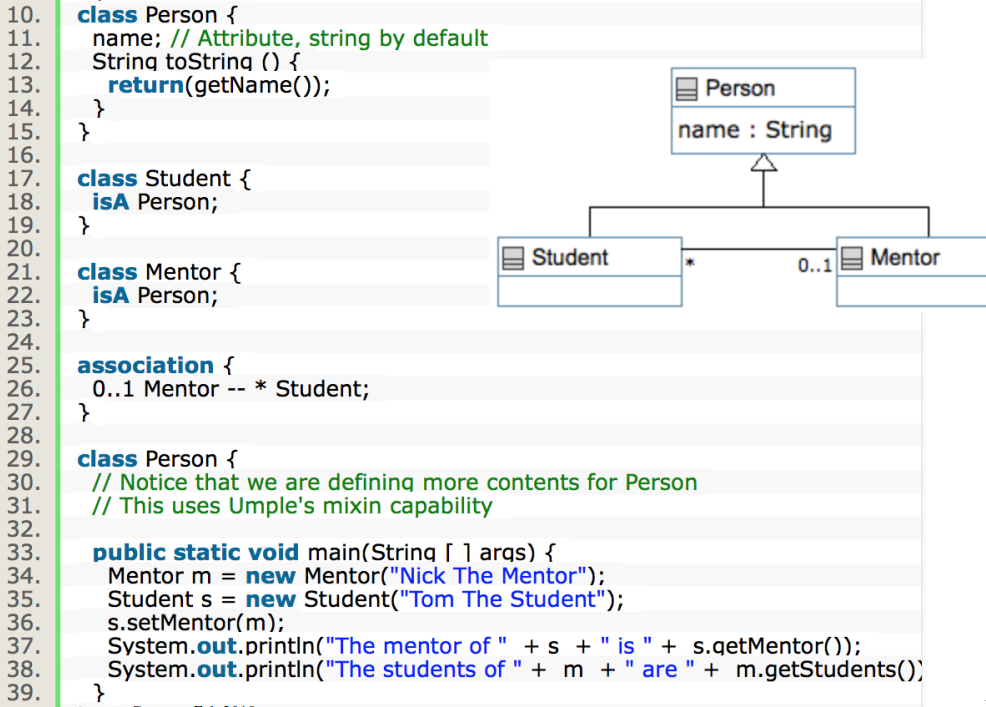
Key tools:¶
- UMPLE Online
- Command-Line
- User Manual
Hello World example 2 in UMPLEOnline¶
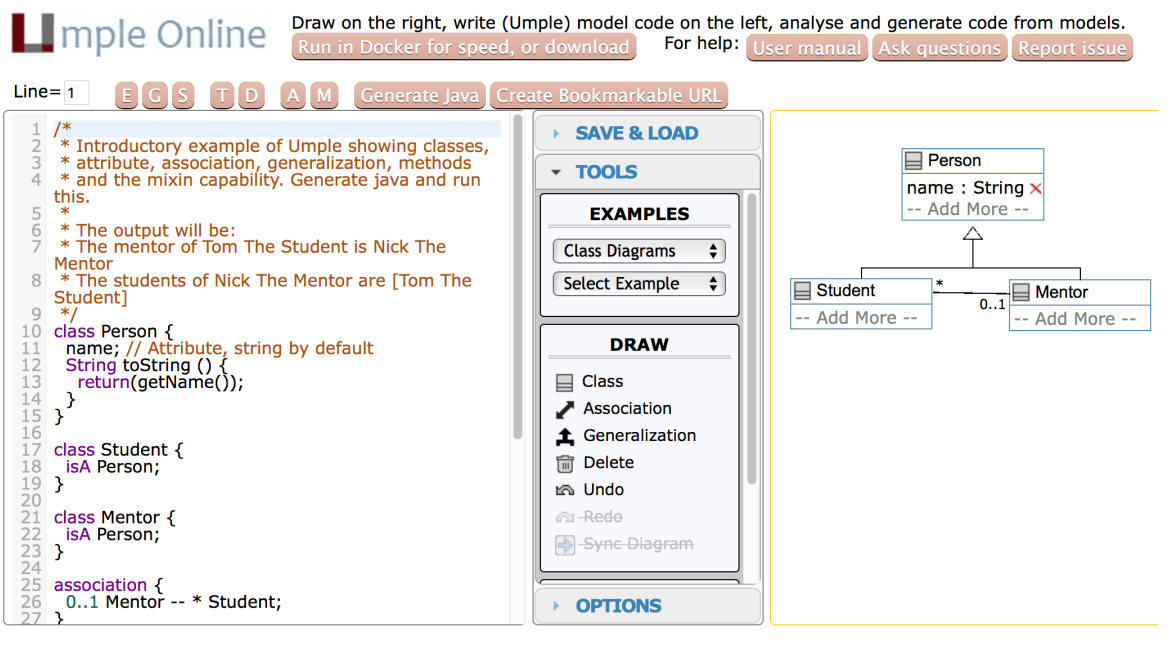
Exploration of UMPLEOnline¶
- Explore class diagram examples
- Options
TorControl-t(hide and show text)DorControl-d(hide and show diagram)A,Mto hide and show attributes, methods- Default diagram types
G/Control-g(Graphviz),S/Control-s(State Diagram)E/Control-e(Editable class diagram)
- Generate code and look at the results
- In UMPLE you never should modify generated code
- It is designed to be readable for educational purposes
Use of the UMPLEOnline Docker image¶
-
UMPLE’s server can handle
80,000transactions per hour -
Code generations, edits
-
But needs a good Internet connection (sometimes hundreds of students have assignments due)
-
To maximize speed of UMPLEOnline run it in your local machine:
-
Follow the instructions at http://docker.UMPLE.org
Demo of compiling on the command line¶
- To compile on the command line you will need Java 8
- Download UMPLE from http://dl.UMPLE.org
- Basic compilation
- Help for features and commands
- To generate and compile the java to a final system
Quick walkthrough of the user manual¶
Note in particular
- Key sections:
- attributes,
- associations,
- state machines
- Grammar
- Generated API
- Errors and warnings
- Editing pages in github
UMPLE Attributes¶
- More than just variables
- http://attributes.UMPLE.org
Attributes¶
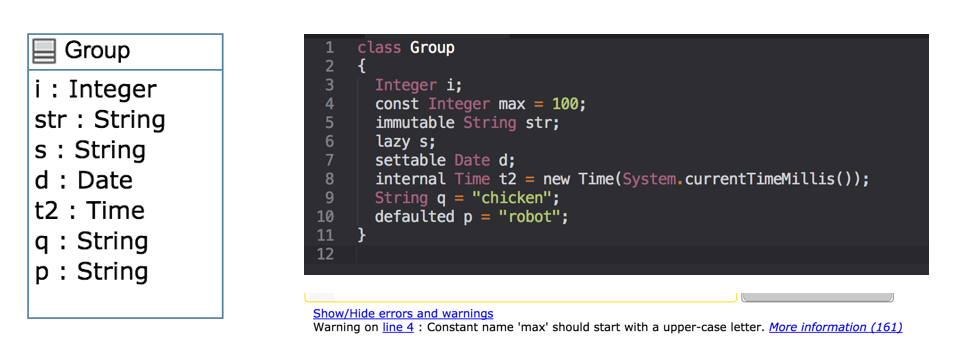
Attributes Exercise #1¶
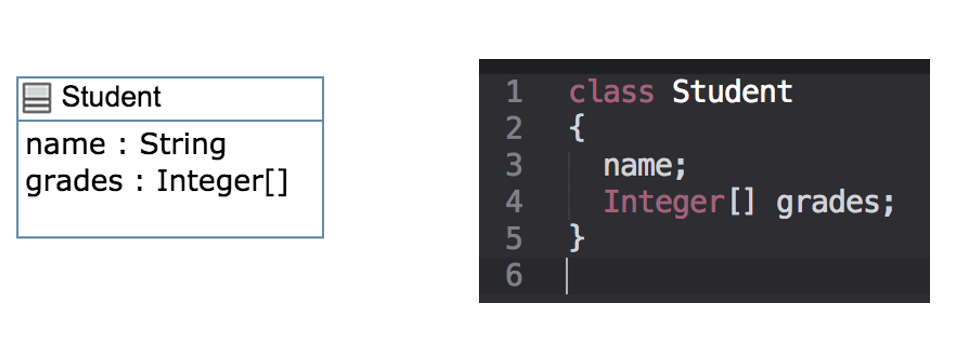
Attributes¶
-
"Instance variables"
-
Part of the state of an object
-
Simple data that will always be present in each instance
-
Specified like a Java or C++ field or member variable
-
But, intended to be more abstract!
-
Example, with an initial value
Attributes¶
-
As in UML, more abstract than instance variables
-
Always private by default
-
Should only be accessed get, set methods
-
Can be stereotyped (upcoming slides) to affect code generation
-
Can have aspects applied (discussed later)
-
Can be constrained (discussed later)
Code generation from attributes¶
- Default code generation
- Generates a
getName()andsetName()method fornamepublic
- Creates an arguments in the class constructor by default
- An attribute is
privateto the class by default - Should only be accessed get, set methods
Code Generation (JavaDocs)¶
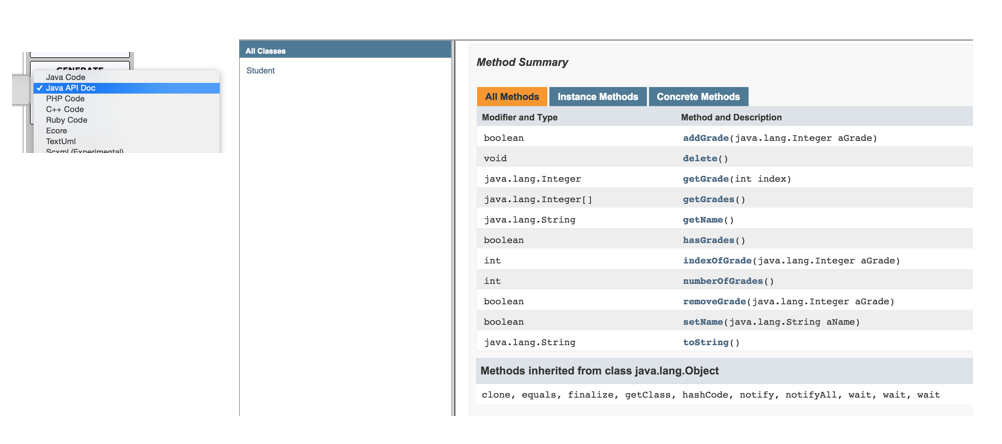
Code Generation Patterns¶
-
Attributes
-
Set/Get (UB = 1)
- Add/Remove/NumberOf/IndexOf/Get (UB > 1)
- Lazy immutability
- Default values
- Constants
- Before / After cod
UB = upper bound
Code Generation Patterns¶
-
Associations
-
Set/Get (UB = 1)
- Add/Remove/NumberOf/IndexOf/Get (UB > 1)
- Referential Integrity
- Multiplicity Constraints
- 42 different cases
UB = upper bound
Code Generation (Semantics)¶
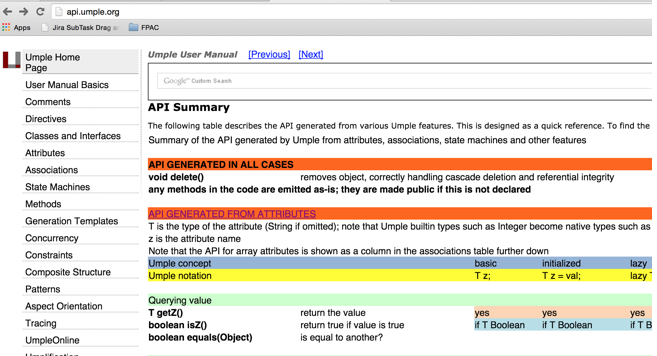
UMPLE builtin datatypes¶
- The above will generate appropriate code in Java, C++ etc.
- e.g. Integer becomes int
- Other (native) types can be used but without guaranteed correctness
Attribute stereotypes (1)¶
- Code generation can be controlled through stereotypes:
- lazy - don’t add a constructor argument
- Defaulted – can be reset
Attribute stereotypes (2)¶
- autounique – provide a unique value to each instance
- internal – don’t generate any methods
Immutability¶
-
Useful for objects where you want to guarantee no possible change once created
-
e.g. a geometric point
-
Generate a constructor argument and get method but no set method
- No constructor argument, but allows setting just once.
Lets explore attributes by example¶
Derived attributes¶
- These generate a get method that is calculated.
class Point
{
// Cartesian coordinates
Float x;
Float y;
// Polar coordinates
Float rho =
{Math.sqrt(Math.pow(getX(), 2) + Math.pow(getY(), 2))}
Float theta =
{Math.toDegrees(Math.atan2(getY(),getX()))}
}
Multi-valued attributes¶
- Limit their use. Associations are generally better.
class Office {
Integer number;
Phone[] installedTelephones;
}
class Phone {
String digits;
String callerID;
}
Keys¶
- Enable UMPLE to generate an
equals()and ahashcode()method
- The user manual has a sports team example showing keys on associations too
- Note how this feature is not inherited from UML
UMPLE Generalization and interfaces¶
Generalization in UMPLE¶
- UMPLE uses the
isAkeyword to indicate generalization - Used to indicate
superclass, usedtrait, implementedinterface
Avoiding unnecessary generalizations¶
-
Inappropriate hierarchy of Classes
-
What should the model be?
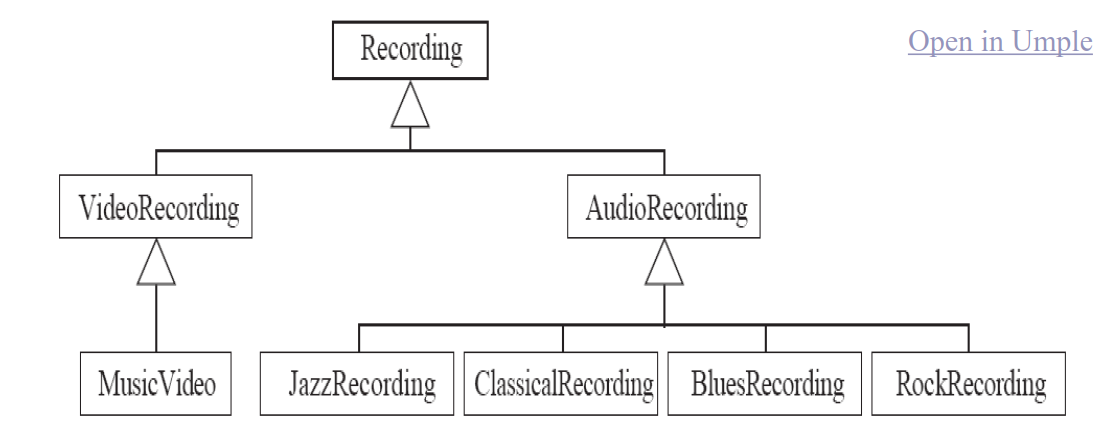
Interfaces¶
-
Declare signatures of a group of methods that must be implemented by various classes
-
Also declared using the keyword
isA -
Essentially the same concept as in Java
-
Let’s explore examples in the user manual …
UMPLE Methods¶
User-written Methods in UMPLE¶
-
Methods can be added to any UMPLE code.
-
UMPLE parses the signature only; the rest is passed to the generated code.
-
You can specify different bodies in different languages
-
We will look at examples in the user manual …
UMPLE Associations¶
-
Notice the inline and independent state machines
Associations¶
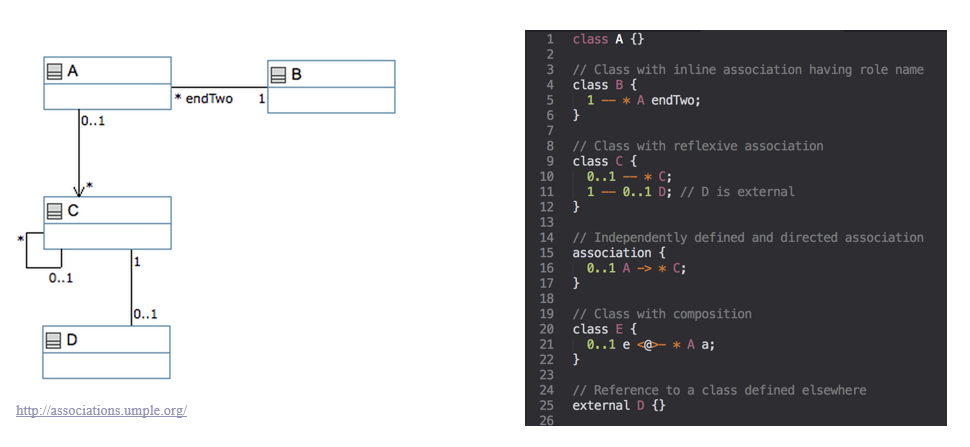
Associations Exercise #1¶
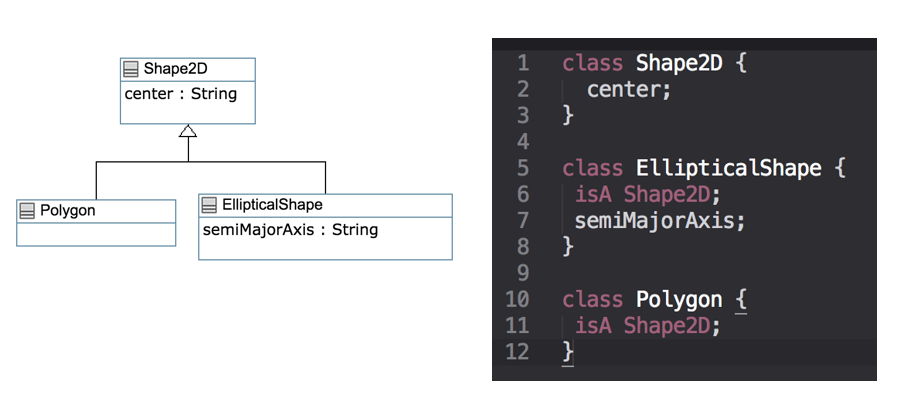
Associations Exercise #2¶
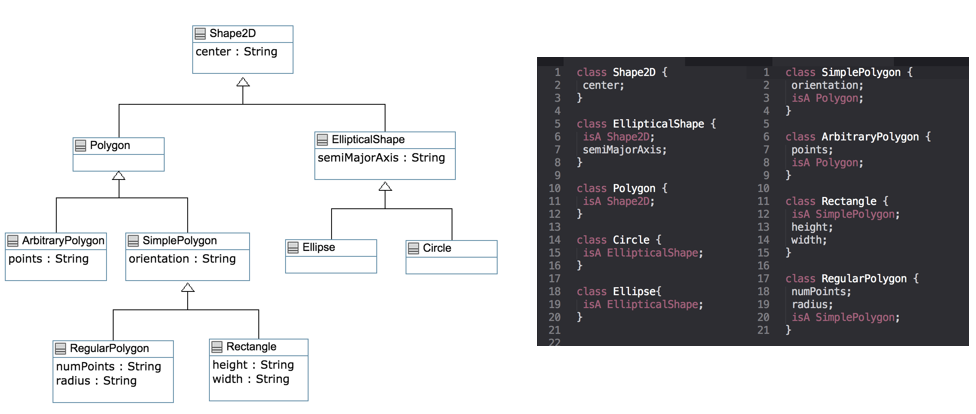
Associations¶
- Describe how instances of classes are linked at runtime
- Bidirectional
--or - Unidirectional
-> - Multiplicity:
- Bounds on the number of linked instances
*Or0..*\(\longrightarrow\) 0 or more1..*\(\longrightarrow\) 1 or more1\(\longrightarrow\) Exactly 12\(\longrightarrow\) Exactly 21..3\(\longrightarrow\) Between 1 and 30..2\(\longrightarrow\) Up to 2
Association Relationships¶

Association Relationships¶
- Directional Associations
- Symmetric Reflexive
Basic UML associations¶
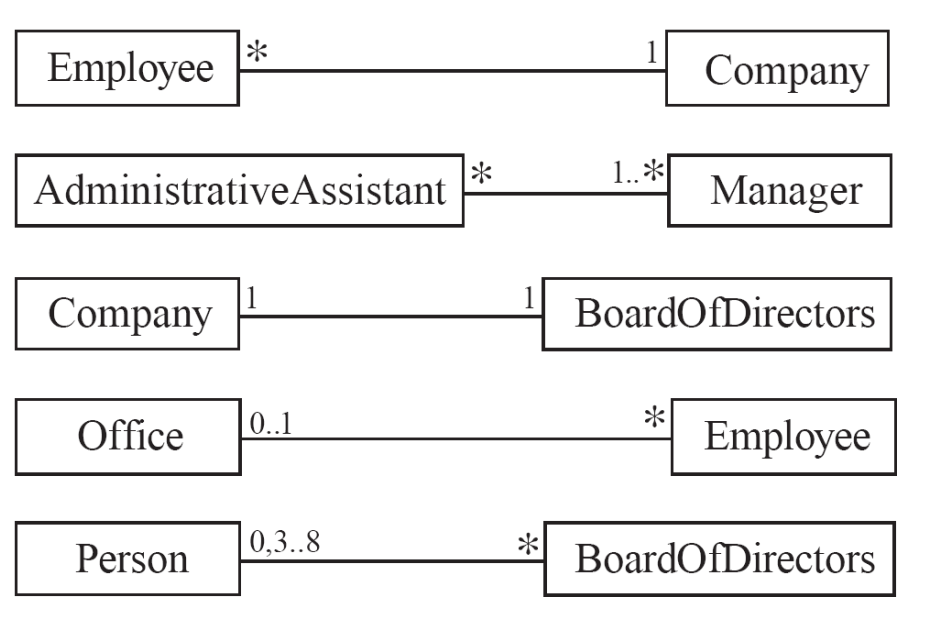
Many-to-one associations (1)¶
Many-to-one associations (2)¶
- A company has many employees,
- An employee can only work for one company.
- This company will not store data about the moonlighting activities of employees!
- A company can have zero employees
- E.g. a ‘shell’ company
- It is not possible to be an employee unless you work for a company
- Let’s draw and write this in UMPLEOnline:

Role names (optional, in most cases)¶
- Allow you to better label either end of an association
Referential Integrity¶
-
When an instance on one side of the association changes
-
The linked instances on the other side know …
-
And vice-versa
-
This is standard in UMPLE associations, which are bidirectional
Many-to-Many Associations¶
- An assistant can work for many managers
- A manager can have many assistants
- Assistants can work in pools working for several managers
- Managers can have a group of assistants
- Some managers might have zero assistants.
- Is it possible for an assistant to have, perhaps temporarily, zero managers?

One-to-One Associations (Use cautiously)¶
- For each company, there is exactly one board of directors
- A board is the board of only one company
- A company must always have a board
- A board must always be of some company

Typical erroneous use of one-to-one¶
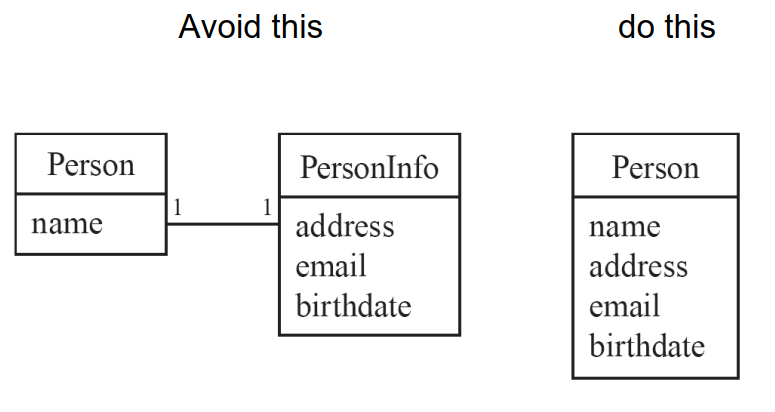
Unidirectional Associations¶
- Associations are by default bi-directional
- It is possible to limit the direction of an association by adding an arrow at one end
- In the following unidirectional association
- A Day knows about its notes, but a Note does not know which Day is belongs to
- Note remains ‘uncoupled’ and can be used in other contexts

Association Classes¶
- Sometimes, an attribute that concerns two associated classes cannot be placed in either of the classes
and Extended Example

- The following are nearly equivalent
- The only difference:
- in the association class there can be only a single registration of a given Student in a CourseSection
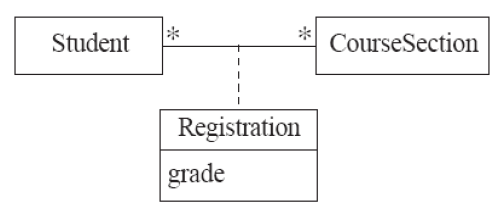
Association classes (cont.)¶
- UMPLE code
class Student {}
class CourseSection {}
associationClass Registration {
* Student;
* CourseSection;
}
- Open in UMPLEOnline, and then generate code
Reflexive Associations¶
- An association that connects a class to itself

class Course {
* self isMutuallyExclusiveWith; // Symmetric
}
association {
* Course successor -- * Course prerequisite;
}
Inline vs. Standalone associations¶
- The following are equivalent to allow flexibility:
Aggregation¶
- Aggregations are ordinary associations that represent part-whole relationships.
- The 'whole' side is often called the assembly or the aggregate
- This is a shorthand for association named
isPartOf - UMPLE has no special syntax currently

Composition¶
- A composition is a strong kind of aggregation
- If the aggregate is destroyed, then the parts are destroyed as well

Sorted Associations¶
- Order objects in the association according to a specific key
- We will look at a more complete example in the User Manual
A final word on associations¶
- More help and examples are in the user manual online at
- http://associations.UMPLE.org
References¶
- UMPLE Tutorials
- UMPLE Github
- UMPLE Online
- UMPLE Documentation
- UMPLE CSI5112– February 2018
- UMPLE Tutorial: Models 2020 Web
- UMPLE Tutorial: Models 2020 Pdf
References¶
- Getting Started in UMPLE
- Experiential Learning for Software Engineering Using Agile Modeling in UMPLE (Youtube)
- Experiential Learning for Software Engineering Using Agile Modeling in UMPLE (Slide)
- Tomassetti Code Generation
\(End-Of-Week-6\)